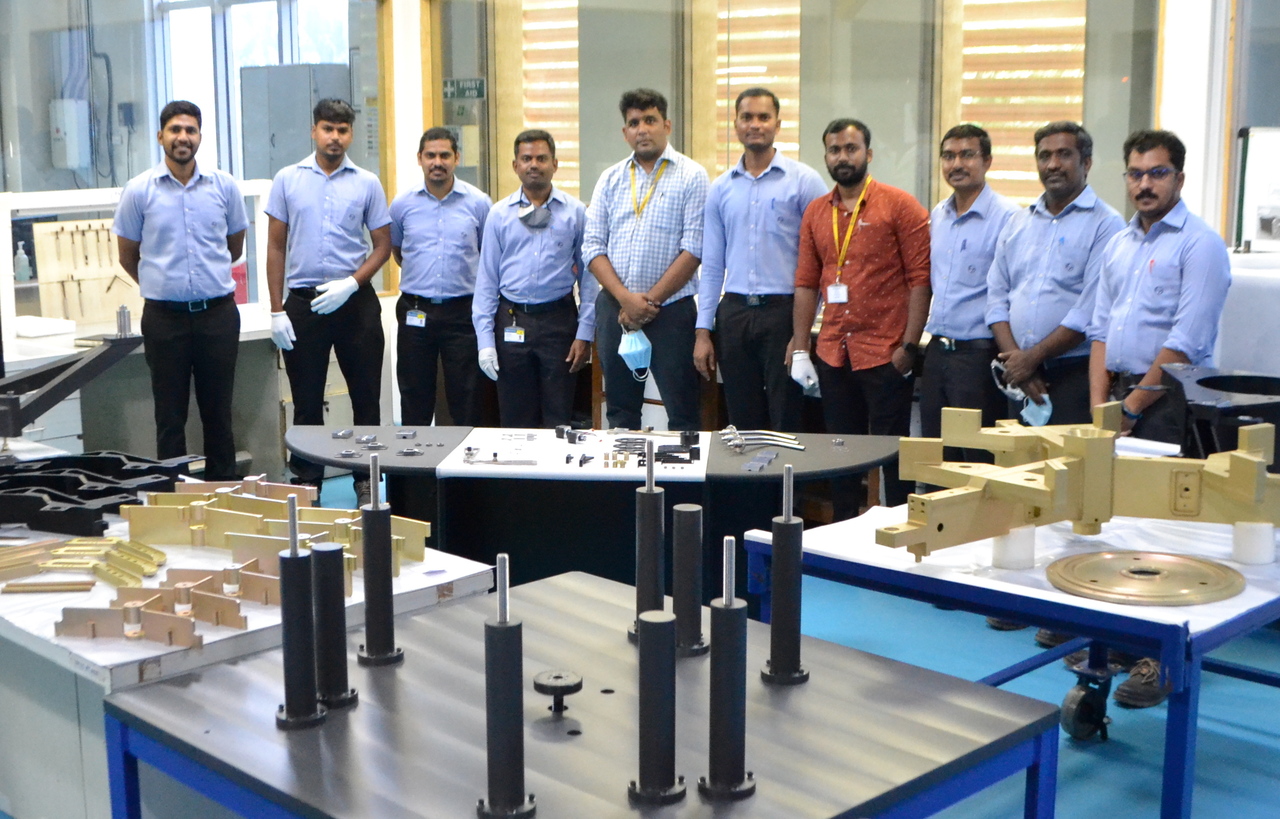
Members of the Segment Support Assembly team in India - Image Credit: Larsen and Toubro Limited

Our colleagues in India are making the mechanical supports for the segments of the primary mirror.
What are the key requirements of each segment support assembly (SSA)? As described elsewhere on this blog, the glass segments have to be positioned very precisely relative to each other, and also supported in a way that doesn't generate stress and deformation at the attachment points— such stress and deformation would change the optical prescription of the glass. It is the SSA that is responsible for providing this precise positioning, and benign support.
Things change over a night's astronomical observations, so the requirements on the SSA design are challenging. As the telescope points to different heights up in the sky, the SSA tilts with respect to gravity. The SSA has to maintain its shape as it tilts, again to minimize stress on the glass. Similarly, the SSA also has to maintain its shape as the external temperature changes during the night, and against any buffeting from the wind.
But while the SSA has to be very stiff against external forces, it needs to be able to flex when we need it to, to counteract residual distortions of the primary mirror that occur despite our best efforts.
All this leads to many very tight tolerances necessary for the precision machining of the SSA components. Here's one such assembly that was fabricated and put together in the USA to check the design. We're looking down through a piece of glass, and you can see many complex parts that need to be machined and integrated.
TMT Segment Support Assembly below hexagonal glass segment - Image Credit: TMT International Observatory, LLC
India has been building up its ability to make hundreds of these SSAs. At least the first 100 will come from Larsen and Toubro (L&T), from its facility in Coimbatore; here's their team:
The team is making the final pieces for the first of the SSAs. Here are some examples:
Central diaphragm shims for TMT Segment Support Assembly made in India - Image Credit: Larsen and Toubro Limited
Hardware components for TMT SSAs - Triangles, Sheet Flexure and Electronics Mount Bracket Components for the Segment Support Assembly manufactured in India - Image Credit: Larsen and Toubro Limited
Moving frame machined for TMT's Segment Support Assemblies fabricated in India - Image Credit: Larsen and Toubro Limited
In the right image, one of TMT's engineers is inspecting one of the most challenging pieces to make, a Moving Frame:
This photo includes most of the team members who will soon be assembling the components:
Members of the Segment Support Assembly team in India. From left to right: Dhiyanesh (L&T), Chermaraja (L&T), Sabarinathan (L&T), S. Karthikeyan (L&T), Nikhil Naik (TMT Project Office), Gowtham K. (L&T), Karthic Kumar (India TMT Co-ordination Centre), Arun DB (L&T), Selvakumar P. (L&T), and Siva Prakash M. (L&T) Image Credit: Larsen and Toubro Limited
The work is funded by the Indian government, through its Department of Science and Technology, and its Department of Atomic Energy. The program is being managed by a government institute, the Indian Institute of Astrophysics, so it is a nice mix of contributions to TMT from the public and private sector in India.
As I've noted elsewhere on this blog, I appreciate the dedication and efforts of the teams across TMT's international partnership in moving forward with making parts for the telescope, despite the added challenges imposed by the current Covid-19 pandemic.
Acknowledgements
My thanks to Nikhil Naik (Production Support Engineer at the TMT Project Office), to Bryan Smith (Work Package Manager at the TMT Project Office), and to Karthic Kumar (Work Package Manager at the India-TMT Co-ordination Centre) for their assistance in writing this article.
TMT ਟੀਮ ਨੰ ਮਿਲੋ (interview in Punjabi)
Audio Universe: Tour of the Solar System